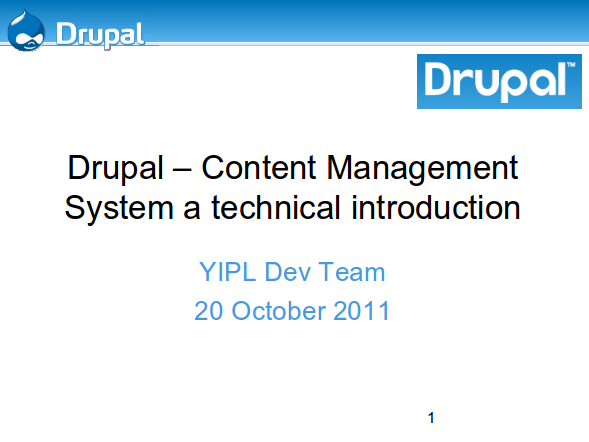
All nodes have a title and an optional description. What's a node?Īlmost every piece of content in Drupal is stored as a single node. Each Link will need a title, URL, and short description. Simply check the boxes and click "Save configuration".īefore we work with users and roles, we'll create our Links content type.
#Drupal cms install#
Get the Views module at Install some modulesĪfter you've downloaded and unpacked the above modules into /webroot/sites/all/modules, you can go ahead and install them.įor this site, we'll need to install the following. They're very useful when you have complex content types and categories. The views module allows you to configure custom views for displaying content. Get a copy of this module over at CCK (Content Construction Kit)ĬCK allows you to easily create new content types, without ever having to write any code! We'll use this for the company's external links section. Originally titled NodeWords, the Meta Tags module allows users to specify common meta tags, like meta keywords and meta description. PathAuto is a module that will have Drupal automatically generate nice URLs. Next, go grab a copy of PathAuto and Token. It's not totally necessary, but it will save you loads of time.ĭownload it over at and place it in /webroot/sites/all/modules PathAuto & Token This module is a must have for working with Drupal.
#Drupal cms download#
Make sure to download the modules compatible with the version of Drupal that you're using. If the modules directory doesn't exist there, just make a new one and name it modules. We'll have to download those and activate them before we can use them.Īll modules that you'll install will be placed in the directory /webroot/sites/all/modules. This will change your URLs from something like /?q=node/3 to just /node/3.Īfter successful installation, you can visit the site and login as the superuser.įor this site, we'll be using a few contributed modules. If your server is configured for mod_rewrite URL rewriting, then you can go ahead and enable Clean URLs now. This user will have permission to do anything and everything on the site.Īnd you can go ahead and specify a few server settings. This is the main administrator, or super user. On the next screen, you'll setup the first account for the site. Also, leave a copy of sites/default/ where it is Drupal will use it during installation.Īfter your config file is created, you can go ahead and install Drupal. Be sure to make it writable to the server. You can copy /webroot/sites/default/ to /webroot/sites/default/settings.php. Installation should be relatively simple for ya. To install Drupal, simply download () and unpack it, create your database, and visit (or your own dev URL). For this tutorial, I'll be working with Drupal 6.x. I'll be developing this one on my local machine, but you can install it anywhere you wish. We'll use as much of the core functionality as we can, and we'll add in a few other modules to make building this site a breeze!įirst, start out by installing Drupal.

Sounds pretty simple, huh? Well with Drupal, a lot of this core functionality is already built in. Submissions of the contact form should be sent only to Shannon. The contact us form will accept the user's name, phone, email, and a short message. The rest of the employees (Bill, Jean, and Terry) should only be able to write blog entries, but Bill may publish links.
#Drupal cms full#
Shannon, the business owner, wants full control over the site. The site will need a few pages in addition to the blogs: SmartMarks is a small marketing consulting firm, with 4 employees. We won't go into theming, as it's a bit out of the scope of this article. We'll begin with outlining the client's needs, installing and configuring a few modules, creating user roles and assigning permissions, and finally we'll add in some content. Here, I'll give a general overview of Drupal and build a simple site for a fake client. It's a great platform for setting up content management systems and community driven sites. Drupal's popularity has lately been rising.


 0 kommentar(er)
0 kommentar(er)
